Interviews
Interview: Art Collector Tuva Tronsdatter Trønsdal
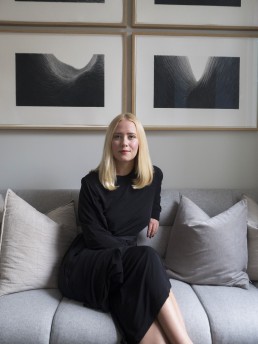
It made a lasting impression on Tuva Tronsdatter Trønsdatter when she, at the age of 14, was standing face to face with Edgar Degas’ work “Blue Dancer” at the Pushkin State Museum of Fine Arts in Moscow. Not only was she drawn to the aesthetics, the experience also marked the beginning of her lifelong dedication to the art world. Today, as a collector and a gallerist for Oslo-based GOLSA, she works dedicatedly to make art more accessible for a new generation of collectors, hoping to be able to contribute to more people having a “Blue Dancer”-moment.
Name: Tuva Tronsdatter Trønsdal
Location: Oslo, Norway
Started collecting in year: 2015
What is your earliest memory of art, and what led you to start collecting it?
I remember that day very clearly. My mom and I traveled to Moscow when I was 14 and we went to see the Pushkin collection. When I saw the Blue Dancer of Edgar Degas, I knew that I would love to work in the field of art.
How would you describe yourself as an art collector?
I would say that I am curious and proactive, seeking new knowledge in order to keep up with the fast-moving art market. At the same time, everything is connected to my personal experiences and my love of art history. I like the idea of supporting artists, galleries, and owning a small fraction of history.
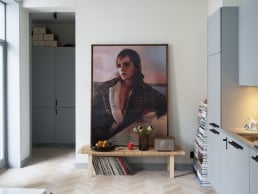
What is the main motivation behind your collecting?
I run the GOLSA gallery in Oslo, and in 2015, my gallery partner and I traveled to Iran to visit the artist Mehdi Ghadyanloo. Through an Iranian collector, we were able to see Farah Adiba’s art collection, which was meant as a gift to the Iranian people but has been kept hidden in a vault since the revolution in 1979. The collection includes works by Lichtenstein, Rivera, Picasso, Warhol, Derain, Judd, LeWitt, Pollock, Calder, Giacometti and a Bacon triptych, among others. Amongst her many patronages, Farah Adiba supported the often controversial Shiraz Arts Festival that ran from 1967 until 1977. The festival featured live performances by Iranian and Western artists including avant-garde performances by John Cage and Karlheinz Stockhausen. She also built a beautiful library mainly containing books about art, philosophy, and religion. This, to me, is such a powerful memory with a symbiosis between architecture, literature, design, and art – established by an inspiring woman. Experiences like that provides me with a lot of motivation.
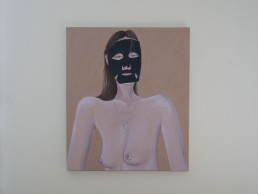
Describe your collection in three words.
Eclectic, personal, and intimate.
Is there any particular type of art that appeals to you or anything that unites all the works in your collection?
I think many have a clear idea of what they like and which aesthetic field they belong to. I have always been very interested in land art, minimalism, and material-based art. This type of aesthetic appealed to me from a very young age. I admire artists like Richard Serra, Ad Reinardt, Franz West, and Urs Fisher, and if price did not matter, I would love a poster painting by Klara Liden or an earlier work by Tauba Auerbach. The funny thing is that when I look at my collection, it does not always match with the idea of what I like. I am not sure why, but I think that is very interesting – I only buy a work when I cannot get it out of my head. I think this creates an undefinable relationship between you as an owner and the work you collect.
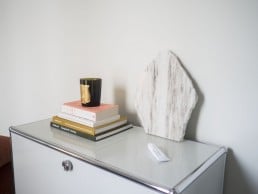
How important is it for you to meet the artist behind the artwork?
I mainly collect artists whom I have a relationship to – it may be people that we have exhibited in the gallery, it may be friends, or maybe I have done some curatorial projects on the side with the artist. There are many other artists I would love to collect, but for now, this is how I would like my collection to grow. It feels very organic.
What is the most recent piece of art you added to your collection and why?
I just bought a painting by Eliza Douglas. She was a part of an exhibition that I curated last December with some very interesting artists like Darja Bajagic, Juliana Huxtable, and Kaari Upson. I used all the money I had left purchasing that painting, and it is too big for my 38 m2 apartment, but I will find a place for it someday.
Has digitalization changed the way you collect art?
I am part of the generation that experienced a huge digitalization and technological growth, and it has obviously had an impact on the way I can collect information about art in general. Information is so accessible, but it can also be overwhelming. Because of that, I believe that it is important to find artists and galleries that are aligned with your way of thinking. I also think that finding people who you can have ongoing discussions about art with is very valuable.

What or who has influenced you as a collector?
It is a mix of all the inspiring people I meet. I admire the collection of Erling Kagge among others. He has been collecting great artists for more than a decade, and often follows the artist in depth from a young age. Collectors like that are important both for the artists and galleries, which in addition creates interesting collections for the future generations to watch.
The art market has a reputation of being a playground for the elite. What is your experience of this?
A part of the vision for the gallery I run, GOLSA, is to make art more accessible to my generation. We want to lower the threshold for people to come into the gallery and get inspired to start collecting themselves. To do this, we want to work with more established artists, but also younger emerging artists. We use the gallery space in a more dynamic way, where we want to open up the space for projects within different aspects of the cultural field. As for example by introducing the concept ‘Got It For Cheap’, where you can buy drawings for 30$. I hope and think there is a growing interest in art among the younger generation.
Where do you think the future of the art market is headed?
More will happen online, but it does not need to challenge the physical spaces or the experience you have when you see an artwork in real life. I hope that there will be an increasing interest in seeing and buying art, and that there will be more women in cultural leader positions and more women collectors.
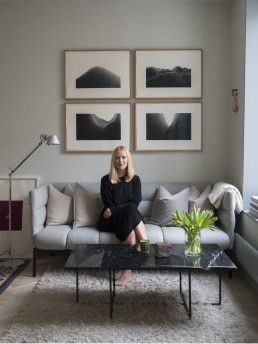
Top three pieces of advice for new collectors
1. Be curious
2. Find people that you think have a good eye for art and begin a dialogue
3. See more – visit galleries, project spaces, and museums
Top three art destinations
1. Oslo – there is a growing variety of gallery spaces in Oslo – great artist-run spaces and galleries that are more commercial. For example, the street where we are located (Waldemar Thranes gate – there you will find our great neighbours; STANDARD and MELK. Ekebergparken is also a place to see with many beautiful site-specific sculptures.
2. Basel and Zurich – galleries in Zurich like Eva Presenhuber and in Basel you will find one of my favourite museums; Fondation Beyeler.
3. Venice – for the biennale, but last year the Palazzo Fortuny and exhibition of Tehching Hsieh were even more interesting.
Three inspiring artists to watch
1. Yves Scherer
2. Mehdi Ghadyanloo
3. Eliza Douglas